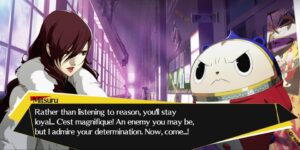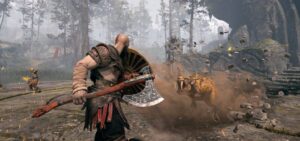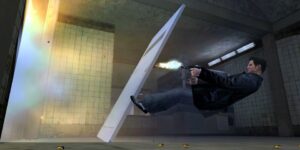While Tango Gameworks is still a relatively young developer, it’s already has a reputation for making horror games, with The Evil Within 1 and 2 being their only games to date. They seemed to be continuing the trend when Ghostwire: Tokyo was announced, but after going hands on with its opening chapters, it’s definitely not what I was expecting.
“Karate meets magic” is how combat director Shinichiro Hara described the combat style in Ghostwire: Tokyo and I have to say, that’s pretty accurate. When I was playing, it felt like playing Yakuza in first person, by way of Halo meets Doctor Strange. That’s one hell of a combination!
You take on the role of Akito Izuki who, after getting into a nasty traffic accident, is saved by mysterious ghost KK. Akito is brought back just in the nick of time, as Tokyo is taken over by evil spirits led by the mysterious Hannya, causing all of its residents to vanish and blocking it from the outside world. Akito then sets off to find his sister Mari amongst all the chaos while learning to get along with his new friend KK.
Like Yakuza, Ghostwire feels authentically Japanese in its presentation. It builds its world and gameplay around Japanese culture and mythology, but there’s also an undeniable quirkiness to it. When I used Spectral Vision to read the thoughts of a cat, it told me it was in a bad mood. I laughed out loud at this.
Exploring this even further, there are cat vendors called Nekomata dotted around the city – ‘Neko’ is Japanese for cat and ‘mata’ referring to the dual tails they have. They love to chat and use lots of cat related puns in their dialogue. It’s purrfect and I love the way that Ghostwire is not trying to take itself too seriously. It helps offset the potential horror on offer and feels more like a mystical brawler where you do indeed have all the power.
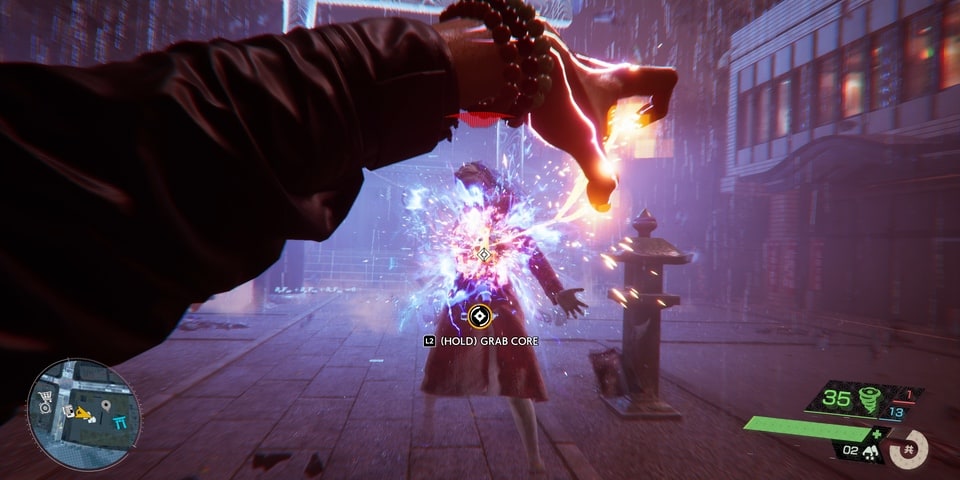
Speaking of which, the power that KK gives to Akito is definitely a fresh spin on the FPS experience, as Akito learns the arts of Ethereal Weaving. Three elements are given to you during the early game, giving access to wield the power of Wind, Fire and Water. Akito performs Kuji-in, also known as Nine Hand Seals, which are a series of symbolic hand gestures which shoot forth the selected element when used. Wind is the first attack you get and is essentially a rapid fire gust of wind. Later, you get the powerful Fire attack and then the wide-spreading Water attack which acts like a shotgun.
You can just blast away until the enemy dies, but to truly be efficient in combat you want to hit the enemy and exposing their core. Once exposed, you hold the left trigger to wrap wires around their cores and rip them out. If you can expose multiple cores at once, you can take all the enemies down at the same time which looks very neat. Combat is generally an exciting explosion of colours.
The enemies also seem pretty varied so far with the main grunts coming in the form of the freaky Rain Walkers, a type of Visitor born from the heart of thoses pushed to exhaustion by their work. I love the details here with everything being explained in the database. Other enemies include headless school girls – AKA ‘Students of Misery’ – the floating Wanderers who attack from afar, and the Paper Dolls who love to spread “negative energy”. This is just to name a few.
Having so many enemy types keeps you on your toes as there are many situations where you find yourself surrounded and you need to know what attacks are coming from where. Your main form of defence is blocking, which can parry the attack and deflect all damage if you time it perfectly.
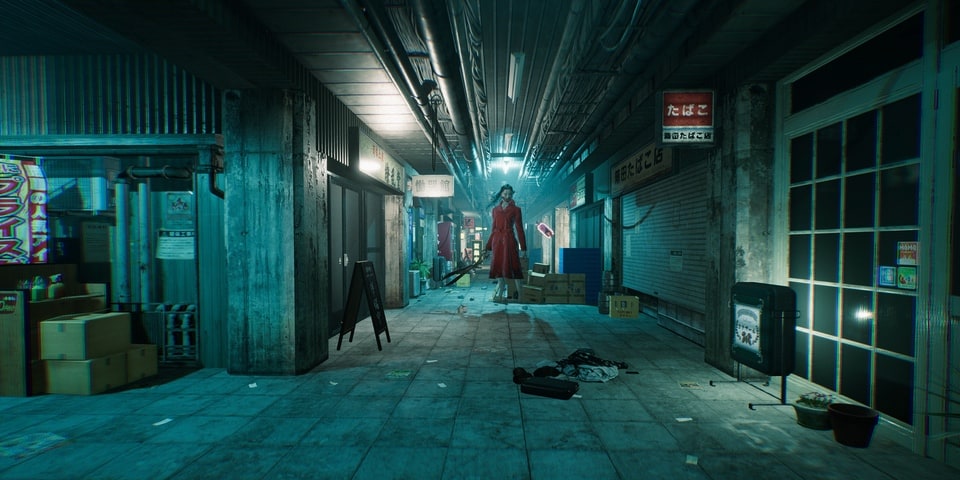
If you get too badly hurt from a fight, you can heal up by eating a whole host of Japanese cuisine found all around Tokyo. The added benefit to this is everytime you munch, it increases your max health by a tiny amount. Since it’s not going to affect your real life waist line, there’s no downside to chowing down constantly.
While exploring Tokyo, there’s also a ton of things to do. The map starts off fairly small, being blocked off by a deadly fog which absorbs peoples spirits. Cleansing Torii Gates clears the fog in surrounding areas, revealing more of the map. With the Spectral Vision you can find points of interest, spirits to rescue and nearby enemies. It also gives you the location of nearby Tengus, which are used to grapple to and subsequently glide from, making travelling around a breeze.
I really liked the fact that there was a lot of vertical space to explore, meaning you could probably spend hours searching every nook and cranny for hidden goodies. And like I said, there’s a lot to do, including optional side missions.
Side missions are worth doing because they net you decent rewards and also provide some sweet mini stories, much like the Yakuza games. The side missions have that strange feel-good aspect as you do the mundane thing to help the simple ghost in need, so they can pass on.
One of the more fun missions has you discovering the ghost of a boy who has fallen in a fountain and is stuck there because he had his shirikodama stolen by a Kappa. According to folklore, Kappa’s love cucumbers so yes, you’ve guessed it, you need to lure the Kappa out with a cucumber and cleanse it while it’s not looking.

There’s so much to talk about even from this opening slice of the game, and I can already say that Ghostwire: Tokyo is shaping up to be a very intriguing adventure with a fun combat style, dripping in beautiful Japanese culture. I cannot wait to get stuck back in.
- About
- access
- accurate
- Action
- Adventure
- All
- announced
- around
- Arts
- beautiful
- City
- coming
- could
- Culture
- damage
- Database
- defence
- Developer
- Director
- Doctor
- down
- During
- Early
- efficient
- Environment
- experience
- Fire
- First
- form
- FPS
- fresh
- fun
- game
- gameplay
- Games
- Gameworks
- Gates
- Ghost
- Ghostwire
- Giving
- Health
- here
- hidden
- hold
- How
- HTTPS
- i
- Including
- interest
- IT
- Japanese
- learning
- Led
- Line
- location
- love
- Making
- map
- mood
- more
- Mythology
- Neat
- net
- offer
- official
- offset
- opening
- Other
- Paper
- Playing
- potential
- power
- powerful
- RELATED
- Rewards
- s
- Said
- School
- selected
- Series
- shotgun
- Simple
- small
- So
- Space
- spend
- Spin
- spread
- stolen
- Stories
- style
- sweet
- The
- time
- tokyo
- Ton
- traffic
- vendors
- vision
- wait
- Water
- What
- WHO
- wield
- wind
- within
- Work
- world
- worth
- yourself
- youtube
